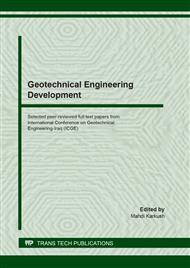[1]
L. Orininová and G. Nguyen. Effect of different values of soils shear strength parameters on the size of spread foundation. XXIV R-S-P seminar, Theoretical Foundation of Civil Engineering (24RSP) (TFoCE 2015), Procedia Engineering 111, (2015), p.612–618.
DOI: 10.1016/j.proeng.2015.07.054
Google Scholar
[2]
E.S. Reddy, D.N. Chapman and V.V.R.N. Sastry. Direct shear interface test for shaft capacity of piles in sand. Geotech. Test J., 23(2), (2000), pp.199-205.
DOI: 10.1520/gtj11044j
Google Scholar
[3]
A.D. Salman. Soaking effects on the shear strength parameters and bearing capacity of soil. University of Technology, Engineering & Technology Journal, 29(6), (2011), pp.1107-1123.
Google Scholar
[4]
A. Johari, S. Mousavi. An analytical solution to reliability assessment of soil shear strength. 8th National Congress on Civil Engineering, Babol Noshirvani, University of Technology, Babol, Iran (2014).
DOI: 10.30880/ijie.2021.13.04.027
Google Scholar
[5]
R. Jain, P.K. Jain and S.S. Bhadauria. Computational approach to predict soil shear strength. International Journal of Engineering Science and Technology 2(8), (2010), pp.3874-3885.
Google Scholar
[6]
Ch.W.W. Ng, and B. Menzies. Advanced Unsaturated Soil Mechanics and Engineering. 1st edition, Taylor & Francis Group, 2007, ISBN 978-0-203-93972-7.
Google Scholar
[8]
A.A. Al-Mufty. Effect of gypsum dissolution on the mechanical behavior of gypseous soils. PhD Thesis (1997), Civil Eng. Dep, University of Baghdad Iraq.
Google Scholar
[9]
I.H. Nashat. Engineering characteristics of some gypseous soils in Iraq. Ph. D. thesis (1990), University of Baghdad, Iraq.
Google Scholar
[10]
S.S. Razouki and M.S. Al-Azawi. Long–term soaking effect on strength and deformation characteristics of a gypsiferous subgrade soil. Engineering Journal of the University of Qatar 16, (2003), pp.49-60.
Google Scholar
[11]
H.O. Abbas and S.M. Muarik, Behavior of compacted gypsiferous sandy Soil during soaking and leaching process. Journal of Wassit for Science & Medicine, 5(1), (2012), pp.165-176. url: http://iasj.net/iasj?func=fulltext&aId=51982.
Google Scholar
[12]
M.Y. Fattah, M.K. Hameedi and M.F. Aswad. Determination of collapse potential of gypseous soil from field and laboratory tests. Diyala Journal of Engineering Sciences, 10(2), (2017), pp.75-85.
DOI: 10.24237/djes.2017.10207
Google Scholar
[13]
F. Stangenberg. Lifetime-oriented structural design concepts. Springer Science & Business Media, p.113, (2009).
Google Scholar
[14]
A.J. Al Abidi and M.Sh. Al-Shakerchy. Groundwater in Al Najaf city and its engineering problems, University of Kufa First Scientific Conference for Pure and Applied Sciences (2008), pp.137-144, Iraq.
Google Scholar
[15]
N.K.S. Al-Saoudi and M.Sh. Al-Shakerchy. Statistical analysis of some geotechnical properties of Najaf city. Proceedings of International Geotechnical Conference, Moscow, Russia, 3, (2010), pp.1173-1180, url: http://geo-bookstore.ru/files/2010-Msk_Volume-3.
Google Scholar
[16]
M.Sh. Al-Shakerchy. Geotechnical properties of Al Najaf city soil with emphasis on the infiltration and strength characteristics, Ph. D. Thesis (2007), Building and Construction Dept., University of Technology, Baghdad, Iraq.
Google Scholar
[17]
N.K.S. Al-Saoudi and M.Sh. Al-Shakerchy. Water infiltration characteristics of Al Najaf city soil, Proceeding of the 4th International Conference on Geotechnical Engineering and Soil Mechanics (2010), Tehran, Iran, Ulr: www.civilica.com/PdfExport-ICGESM04_263=Water-Infiltration-Characteristics-of-Al-Najaf-City-Soil.pdf.
DOI: 10.35940/ijeat.b2655.029320
Google Scholar
[18]
N.K.S. Al-Saoudi, M.Sh. Al-Shakerchy and S.A.A. Al-Janabi. Water infiltration characteristics for suggested artificial lake in Bahr Al-Najaf. Proceedings of 1st International Conference on Geotechnical and Transportation Engineering ICGTE 2013, Baghdad, Iraq, (2013).
DOI: 10.1201/b14895-13
Google Scholar
[19]
N.K.S. Al-Saoudi, M.Sh. Al-Shakerchy and M.M. Abdalhusain. Infiltration characteristics in agriculture area of Bahr al Najaf. Journal of Babylon University Engineering Sciences, 22(4), (2014), pp.971-978.
Google Scholar
[20]
M.Sh. Al-Shakerchy. Effect of water head on the infiltration characteristics by using the laboratory tests. Al-Qadisiya Journal for Engineering Sciences, 2(4), (2009), pp.664-681.
Google Scholar
[21]
M.Sh. Mahmood. Effect of soaking on the compaction characteristics of Al-Najaf sand soil. Kufa Journal of Engineering, 9(2), (2018), pp.1-12. http://dx.doi.org/10.30572/2018/kje/090201.
DOI: 10.30572/2018/kje/090201
Google Scholar
[22]
M.Sh. Mahmood, L.J. Aziz and A.M.B. Al-Gharrawi. Load-time-settlement behavior of sand soil upon soaking process using oedometer test. International Journal of Civil Engineering and Technology (IJCIET), 9(11), (2018), pp.860-869.
Google Scholar
[23]
M.Sh. Mahmood, A. Akhtarpour, R. Almahmodi and M.M. Abdal Husain. Settlement assessment of gypseous sand after time-based soaking. IOP conferences, Proceeding of 4th International Conference on Buildings Construction and Environmental Engineering (BCEE4) (2019), Istanbul, Turkey.
DOI: 10.1088/1757-899x/737/1/012080
Google Scholar
[24]
M.M. Abdalhusein, A. Akhtarpour and M.Sh Mahmood. Effect of soaking on unsaturated gypseous sand soils. International Journal of Civil Engineering and Technology 10(5) 2019 550-558.
DOI: 10.35741/issn.0258-2724.54.5.3
Google Scholar
[25]
M.M. Abdalhusein, A. Akhtarpour and M.Sh. Mahmood. Effect of wetting process with presence of matric suction on unsaturated gypseous sand soils. Journal of Southwest Jiaotong University ,54(5), 2019, pp.1-11. https://doi.org/10.35741/issn.0258-2724.54.5.3.
DOI: 10.35741/issn.0258-2724.54.5.3
Google Scholar
[26]
M.Sh. Mahmood. Effect of time-based soaking on shear strength parameters of sand soils. Applied Research Journal, 3(5), 2017, pp.142-149.
Google Scholar
[27]
Information on http://www.inrisk.ubc.ca.
Google Scholar


